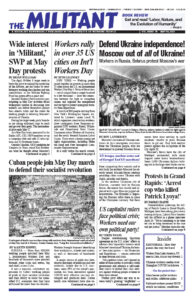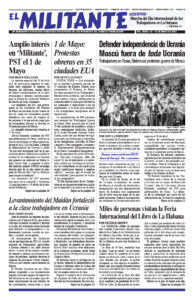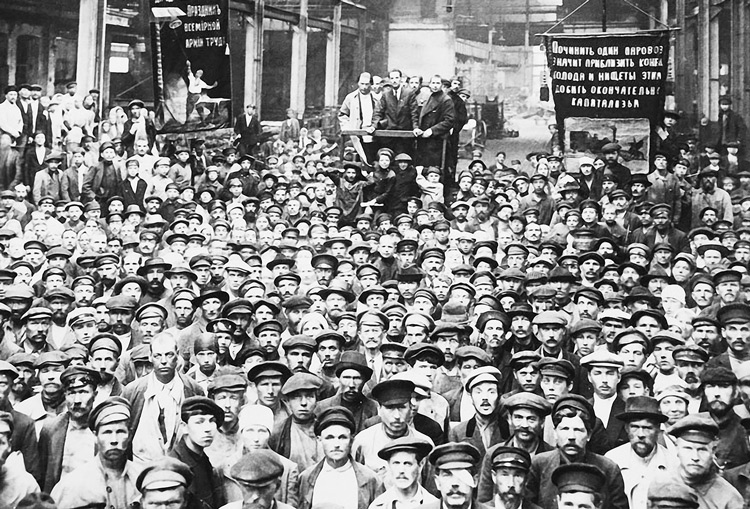Labor, Nature, and the Evolution of Humanity: The Long View of History by Frederick Engels, Karl Marx, George Novack and Mary-Alice Waters; 177 pages, Pathfinder Press, 2021.
BY BETSEY STONE
Labor, Nature, and the Evolution of Humanity: The Long View of History is a collection of writings covering the sweep of human history, from the evolution of our earliest ancestors, through the emerging of class society, up to capitalism today.
Why is that record important? As Socialist Workers Party leader Mary-Alice Waters says in the book’s first chapter, without this we become “prisoners of the moment in which we live,” unable to see beyond the capitalist exploitation that warps every aspect of our lives.
The book is an introduction to scientific socialism, first put forward in the mid-1800s by Karl Marx and Frederick Engels, founders of the modern working-class movement. They were students of science and history not for its own sake, Waters points out, but “because that knowledge was necessary to organize the working class and its allies and help them find the road to their emancipation.”
I first became interested in Marxism in the early 1960s after getting involved in the civil rights movement and becoming a partisan of the Cuban Revolution where workers and peasants, led by Fidel Castro, had taken power.
When I asked my history teacher what she thought of Marxism, she dismissed it. “You can’t have a science of history,” she said. “You are talking about people, not objects. And every person is different. It’s too complicated.”
Fortunately, members of the Socialist Workers Party got into my hands works by Marx and Engels and a pamphlet containing articles by party leader George Novack under the title The Long View of History. Now that pamphlet is part of this new book, which updates, amplifies and reinforces the material in Novack’s articles, providing a powerful tool to those looking for a road to end capitalist exploitation.
Novack indicates key turning points when revolutionary changes took place, from the evolution of mammals, through the early Stone Age societies, to the rise of civilization, to today.
What you learn is that while human history is complex, there are laws of development that can be seen and that point to the class-struggle road forward.
It is drummed into our heads that you can’t change human nature. Yet, as Novack illustrates, the history of the earth and humanity is one of constant change. Marx and Engels saw that advances in how humans provide for food, shelter and other material needs are the driving force behind changes in human societies. The book includes Engels’ essay “The Part Played by Labor in the Transition from Ape to Man,” which describes how collective labor transforming nature was key to the evolution of the first human beings.
For most of humanity’s history, production was based on hunting and gathering. These societies had no ruling class and no private property. This changed decisively a few thousand years ago based on advances in agricultural production. For the first time, humans were able to produce a surplus over what was necessary to survive, leading to the rise of slave labor and a ruling class that lived off that surplus, as well as armies to defend the property of the ruling few.
Evolution of class struggle
Novack describes the line of evolution after the rise of class society, from slavery to feudalism, and then capitalism. At each stage advances in labor productivity led to the rise of new property relations and new ruling classes that challenged and supplanted outmoded social systems.
“Just as Darwin discovered the law of development of organic nature, so Marx discovered the law of the development of human history,” Engels says in a tribute to Marx reprinted in the book. Economic development in any epoch forms “the foundation upon which the state institutions, the legal conceptions, art, and even the ideas on religion, of the people concerned have been evolved.”
As capitalism spread throughout the world, a modern working class was created, with the social power and capacity to bring an end to class exploitation and oppression.
“The history of all hitherto existing society is the history of class struggles,” Marx and Engels wrote at the start of the Communist Manifesto. Such an understanding, Waters points out, is the polar opposite of the “woke” views spreading among privileged middle-class layers today in universities, the media and the Democratic Party.
Pointing to the New York Times-sponsored 1619 Project, Waters says its author, Nikole Hannah-Jones, “joins the chorus of those who argue that the driving force behind the entire history of the ‘Western World,’ including the U.S. to this day, has been the ongoing dominance of people with a white skin who act on the belief they are a superior ‘race’ entitled to privilege and power.”
“This rewriting of history is false,” Waters says. “It is not racist attitudes, psychological mechanisms, or ideas — in fact it’s not ideas of any kind — that drive human social relations. It is our material conditions of life that shape our ideas.”
What has been the main force driving social relations in the U.S.? It’s capitalism. Slavery on the American continent was a product of the capitalist market. When it became a fetter on capitalism the slave system was destroyed in the Civil War, the Second American Revolution. Racist oppression continues because it benefits the capitalists. It will take a struggle by working people united across lines of race, nationality and sex to change that.
The Communist Manifesto explains “the proletarian movement is the self-conscious, independent movement of the immense majority, in the interests of the immense majority.”
This has been proven time and again since this was written in 1848, most importantly by the 1917 Bolshevik-led Russian Revolution in the years before it was throttled by the Stalinist counterrevolution, and by the Cuban Revolution. Both revolutions replaced capitalist rule with workers’ power, bringing gains not only for working people but for peasants, women and oppressed nationalities.
Workers engaged in union struggles to defend wages and conditions today, and those trying to figure out how to end murderous wars like Moscow’s assault on Ukraine and how to prevent the bosses’ destruction of the earth’s natural resources will find this book invaluable. Fighters everywhere need a long view of history to prepare us for new openings to challenge capitalist rule that will develop as the crisis of their system deepens and class struggles pick up.
Labor, Nature, and the Evolution of Humanity: The Long View of History is a good place to start.


